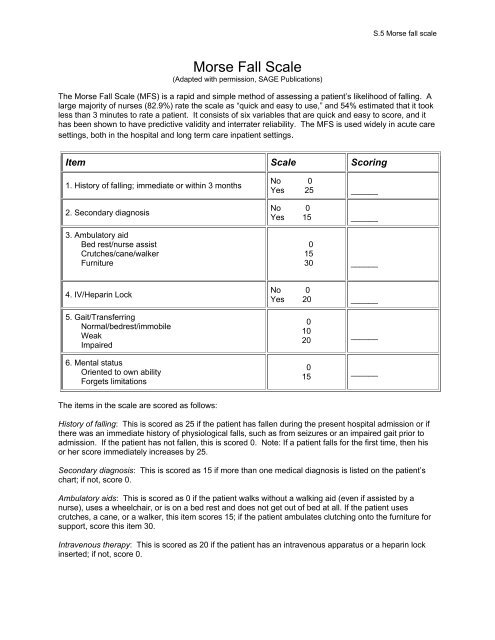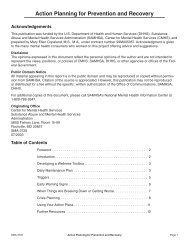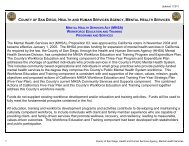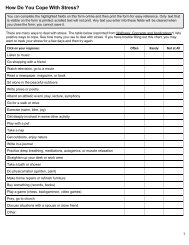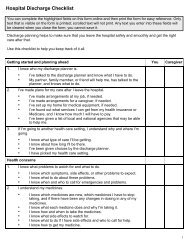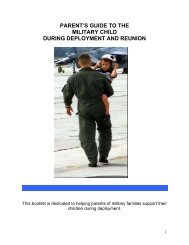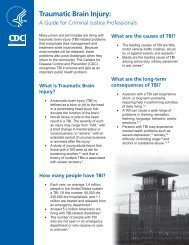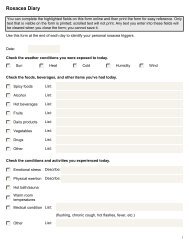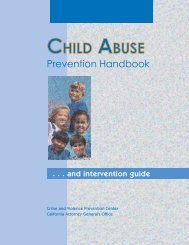Morse Fall Scale - pdf - Network Of Care
Morse Fall Scale - pdf - Network Of Care
Morse Fall Scale - pdf - Network Of Care
- No tags were found...
You also want an ePaper? Increase the reach of your titles
YUMPU automatically turns print PDFs into web optimized ePapers that Google loves.
S.5 <strong>Morse</strong> fall scale<strong>Morse</strong> <strong>Fall</strong> <strong>Scale</strong>(Adapted with permission, SAGE Publications)The <strong>Morse</strong> <strong>Fall</strong> <strong>Scale</strong> (MFS) is a rapid and simple method of assessing a patient’s likelihood of falling. Alarge majority of nurses (82.9%) rate the scale as “quick and easy to use,” and 54% estimated that it tookless than 3 minutes to rate a patient. It consists of six variables that are quick and easy to score, and ithas been shown to have predictive validity and interrater reliability. The MFS is used widely in acute caresettings, both in the hospital and long term care inpatient settings.Item <strong>Scale</strong> Scoring1. History of falling; immediate or within 3 months2. Secondary diagnosis3. Ambulatory aidBed rest/nurse assistCrutches/cane/walkerFurnitureNo 0Yes 25 ______No 0Yes 15 ______01530 ______4. IV/Heparin LockNo 0Yes 20 ______5. Gait/TransferringNormal/bedrest/immobileWeakImpaired6. Mental statusOriented to own abilityForgets limitations01020015____________The items in the scale are scored as follows:History of falling: This is scored as 25 if the patient has fallen during the present hospital admission or ifthere was an immediate history of physiological falls, such as from seizures or an impaired gait prior toadmission. If the patient has not fallen, this is scored 0. Note: If a patient falls for the first time, then hisor her score immediately increases by 25.Secondary diagnosis: This is scored as 15 if more than one medical diagnosis is listed on the patient’schart; if not, score 0.Ambulatory aids: This is scored as 0 if the patient walks without a walking aid (even if assisted by anurse), uses a wheelchair, or is on a bed rest and does not get out of bed at all. If the patient usescrutches, a cane, or a walker, this item scores 15; if the patient ambulates clutching onto the furniture forsupport, score this item 30.Intravenous therapy: This is scored as 20 if the patient has an intravenous apparatus or a heparin lockinserted; if not, score 0.
S.5 <strong>Morse</strong> fall scaleGait: A normal gait is characterized by the patient walking with head erect, arms swinging freely at theside, and striding without hesitant. This gait scores 0. With a weak gait (score as 10), the patient isstooped but is able to lift the head while walking without losing balance. Steps are short and the patientmay shuffle. With an impaired gait (score 20), the patient may have difficulty rising from the chair,attempting to get up by pushing on the arms of the chair/or by bouncing (i.e., by using several attempts torise). The patient’s head is down, and he or she watches the ground. Because the patient’s balance ispoor, the patient grasps onto the furniture, a support person, or a walking aid for support and cannot walkwithout this assistance.Mental status: When using this <strong>Scale</strong>, mental status is measured by checking the patient’s own selfassessmentof his or her own ability to ambulate. Ask the patient, “Are you able to go the bathroom aloneor do you need assistance?” If the patient’s reply judging his or her own ability is consistent with theambulatory order on the Kardex®, the patient is rated as “normal” and scored 0. If the patient’s responseis not consistent with the nursing orders or if the patient’s response is unrealistic, then the patient isconsidered to overestimate his or her own abilities and to be forgetful of limitations and scored as 15.Scoring and Risk Level: The score is then tallied and recorded on the patient’s chart. Risk level andrecommended actions (e.g. no interventions needed, standard fall prevention interventions, high riskprevention interventions) are then identified.Important Note: The <strong>Morse</strong> <strong>Fall</strong> <strong>Scale</strong> should be calibrated for each particular healthcare setting or unitso that fall prevention strategies are targeted to those most at risk. In other words, risk cut off scores maybe different depending on if you are using it in an acute care hospital, nursing home or rehabilitationfacility. In addition, scales may be set differently between particular units within a given facility.Sample Risk LevelRisk Level MFS Score ActionNo Risk 0 - 24 Good Basic Nursing <strong>Care</strong>Low Risk 25 - 50High Risk ≥ 51Implement Standard <strong>Fall</strong>Prevention InterventionsImplement High Risk <strong>Fall</strong>Prevention Interventions


